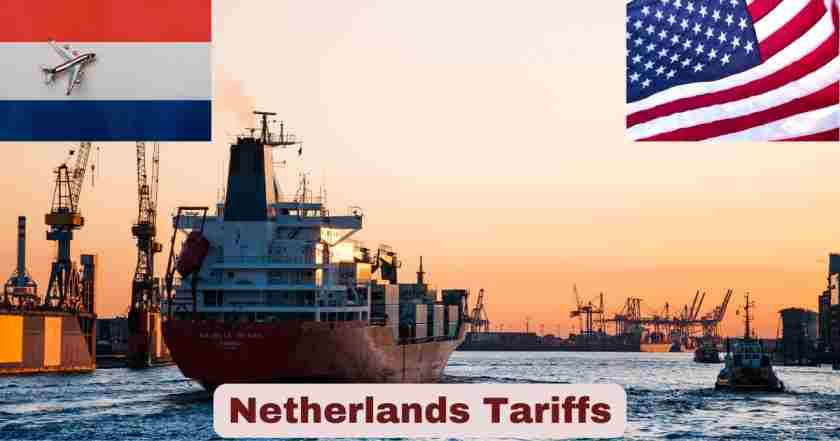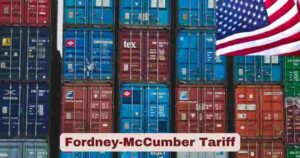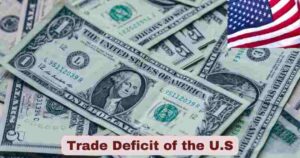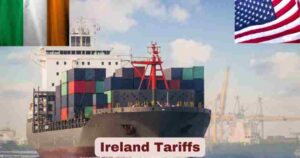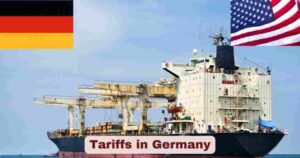Netherlands Tariffs in 2025
The Netherlands tariff landscape in 2025 represents a critical juncture in international trade relations, particularly amid escalating trade tensions between the United States and European Union member states. As one of Europe’s most trade-dependent economies, the Netherlands faces unprecedented challenges with new US import tariffs averaging 15 percent across multiple sectors that have significantly impacted bilateral commerce. The country’s position as a major re-export hub and its sophisticated manufacturing base make it particularly vulnerable to tariff fluctuations, especially in sectors like steel, aluminum, and high-tech machinery.
Recent developments in 2025 tariff policies have created substantial ripple effects throughout the Dutch economy, with official government statistics revealing that 8.5 percent of total Dutch exports to the United States are now subject to the 15 percent US tariff rate, with specific sectors facing even higher rates including 25 percent tariffs on steel and aluminum products. The implementation of this 15 percent baseline tariff structure, alongside sector-specific increases, has forced Dutch businesses to reassess their export strategies and supply chain management. This comprehensive analysis examines the latest official data from both US and Dutch government sources to provide an accurate assessment of the current tariff environment and its implications for Netherlands-US trade relations.
Netherlands Tariff Stats & Facts in 2025
| Tariff Category | Rate/Value | Impact | Effective Date |
|---|---|---|---|
| US Tariffs on Netherlands | 15% | €38.4 billion export exposure | January 2025 |
| US Steel Tariffs on Netherlands | 25% | €853.5 million export value affected | March 2025 |
| US Aluminum Tariffs on Netherlands | 25% | €2.3 billion export value affected | March 2025 |
| Total Dutch Exports to US | €38.4 billion | 5.7% of total Dutch exports | 2024 |
| Tariff-Affected Export Share | 8.5% | €3.3 billion in affected trade | 2025 |
| Netherlands Average Tariff Rate | 1.39% | EU Common Customs Tariff | 2025 |
| Machinery Exports Hit by Tariffs | €930.8 million | 29% of tariff-affected goods | 2025 |
| Aircraft Component Tariffs | €668.1 million | 16% of affected export value | 2025 |
| Expected GDP Impact | -0.4% | Reduced from 1.8% to 1.4% growth | 2025 forecast |
The Netherlands tariff environment in 2025 demonstrates the significant economic pressure facing one of Europe’s most export-oriented economies. The data reveals that while the Netherlands maintains relatively low average tariff rates as an EU member state, the country faces substantial challenges from US retaliatory tariffs that target key Dutch export sectors. The €3.3 billion worth of Dutch exports now subject to 25 percent US tariffs represents a major shift in trade dynamics, particularly affecting the country’s competitive position in steel, aluminum, and high-tech manufacturing sectors.
Analysis of the latest government statistics shows that specialized machinery and components bear the heaviest burden, with €930.8 million in export value affected by the new tariff regime. This concentration in high-value manufacturing sectors underscores the Netherlands’ vulnerability to trade policy changes, as these industries form the backbone of the country’s export economy. The 16 percent impact on aircraft components, valued at €668.1 million, further highlights how modern tariff policies target sophisticated manufacturing chains where the Netherlands has traditionally maintained competitive advantages through innovation and precision engineering.
US Import Tariffs Impact on Netherlands Economy in 2025
| Economic Indicator | Pre-Tariff Forecast | Post-Tariff Reality | Change |
|---|---|---|---|
| Dutch GDP Growth 2025 | 1.8% | 1.4% | -0.4% reduction |
| Dutch GDP Growth 2026 | 1.0% | 1.3% | +0.3% adjustment |
| Inflation Rate 2026 | 2.8% | 3.0% | +0.2% increase |
| US Export Decline | Baseline | -27% | Significant reduction |
| Dutch Import-Export Decline | Baseline | -1% | Moderate impact |
| Manufacturing Sector Impact | Stable | Larger decline | Sector-specific |
| Service Sector Performance | Stable | Benefits | Positive offset |
The economic ramifications of US tariffs on the Netherlands have forced major revisions to the country’s growth projections for 2025. The De Nederlandsche Bank and other leading financial institutions have adjusted their forecasts, with ABN AMRO reducing Dutch GDP growth expectations from 1.8 percent to 1.4 percent for 2025. This 0.4 percentage point reduction represents a significant economic drag that reflects the interconnected nature of modern trade relationships and the Netherlands’ particular vulnerability as a highly open economy dependent on international commerce.
The inflation impact of these tariff policies adds another layer of complexity to the Netherlands’ economic outlook. With inflation projections rising from 2.8 percent to 3.0 percent for 2026, Dutch consumers and businesses face the dual challenge of reduced export competitiveness and increased domestic price pressures. However, the data also reveals some resilience in the Dutch economy, with service sectors actually benefiting from trade disruptions as businesses seek alternative arrangements and the country’s role as a logistics hub gains importance despite manufacturing sector challenges.
Netherlands Steel and Aluminum Tariff Analysis in 2025
| Product Category | Export Value (€ millions) | Tariff Rate | Market Share Impact |
|---|---|---|---|
| Aluminum Products | €2,160 | 25% | Major impact |
| Steel Products (2018 rates) | €880 | 25% | Continued pressure |
| Flat-rolled Steel | €852.5 | 25% | Largest steel category |
| Total Metal Exports Affected | €3,300 | 25% | 8.5% of US exports |
| Germany Market (comparison) | Largest market | No tariffs | Competitive advantage |
| Steel Components | €50 | 25% | Supply chain disruption |
The steel and aluminum sector represents the most severely impacted area of Netherlands-US trade relations in 2025. With €2.16 billion in aluminum exports and €852.5 million in flat-rolled steel products facing 25 percent tariffs, Dutch metal producers confront unprecedented competitive disadvantages in the crucial US market. The United States previously ranked as the second-largest market for Dutch steel and aluminum products after Germany, making these tariff increases particularly damaging to sector profitability and long-term investment planning.
The reinstatement of 2018 tariff policies alongside new measures creates a complex regulatory environment that Dutch exporters must navigate. The €880 million in steel products that were subject to previous tariff regimes now face continued pressure, while the massive €2.16 billion aluminum sector confronts entirely new barriers. This dual impact demonstrates how trade policy uncertainty can create lasting damage to established business relationships, as Dutch companies that invested heavily in US market development now face structural disadvantages that may persist beyond current political cycles.
Netherlands Machinery and High-Tech Exports Tariff Impact in 2025
| Technology Sector | Export Value (€ millions) | Percentage of Affected Trade | Strategic Importance |
|---|---|---|---|
| Specialized Machinery | €930.8 | 29% | Highest impact category |
| Aircraft Components | €668.1 | 16% | Aerospace industry |
| Vehicle Components | €154.2 | 5% | Automotive supply chain |
| Packaging Materials | Included | Variable | Derived products impact |
| High-tech Manufacturing | 30% of imports | Counter-tariff exposure | Two-way impact |
| Medical Equipment | Significant | Under review | Healthcare sector |
The high-technology sectors face disproportionate impacts from the 2025 tariff regime, with specialized machinery and components accounting for €930.8 million or 29 percent of all tariff-affected Dutch exports to the United States. This concentration in sophisticated manufacturing reflects the Netherlands’ competitive positioning in precision engineering and advanced manufacturing, sectors that have traditionally driven the country’s export success and attracted significant foreign investment. The targeting of these high-value industries through tariff policy represents a strategic challenge that goes beyond immediate revenue impacts.
Aircraft and aerospace components, valued at €668.1 million and representing 16 percent of affected trade, highlight the global nature of modern manufacturing supply chains. Dutch companies that have integrated deeply into international aerospace production networks now face cost disadvantages that may force restructuring of established business relationships. The European Commission’s counter-tariffs affecting 30 percent of Dutch imports create additional complexity, as Dutch high-tech manufacturers face increased costs for both exports and imports, potentially triggering broader supply chain reorganization across multiple sectors.
Netherlands Trade Balance Effects and Tariff Responses in 2025
| Trade Relationship | Value (€ billions) | Growth Rate | Tariff Exposure |
|---|---|---|---|
| Total US Exports | €38.4 | +15.2% from 2023 | 8.5% affected |
| Domestic Exports to US | €27.0 | +14.9% from 2023 | Higher exposure |
| Re-exports to US | €11.4 | +10.7% from 2023 | Lower exposure |
| US as Export Destination | 5.7% | Fifth largest market | Moderate dependency |
| EU Counter-tariff Impact | 30% | Import value affected | Reciprocal measures |
| Alternative Market Development | Under development | Strategic priority | Risk mitigation |
The Netherlands’ trade balance with the United States demonstrates remarkable resilience despite mounting tariff pressures, with total exports reaching €38.4 billion in 2024, representing a 15.2 percent increase from the previous year. This growth occurred even as trade tensions escalated, indicating the underlying strength of Netherlands-US commercial relationships and the difficulty of quickly redirecting established trade flows. However, the 8.5 percent of exports now subject to tariffs creates significant uncertainty for future growth trajectories.
Re-export activities, valued at €11.4 billion, show continued strength with 10.7 percent growth, reflecting the Netherlands’ enduring role as Europe’s gateway for international trade. This segment faces lower direct tariff exposure but remains vulnerable to broader trade disruptions and supply chain reorganization. The European Union’s counter-tariff measures affecting 30 percent of Dutch import value create additional complexity, as Dutch businesses must navigate both outbound export restrictions and inbound supply cost increases, potentially accelerating the development of alternative trade relationships and supply chain diversification strategies.
Netherlands Inflation and Economic Projections Under Tariff Pressure in 2025
| Economic Metric | December 2024 Projection | Current 2025 Forecast | Tariff Impact |
|---|---|---|---|
| Inflation Rate 2026 | 2.8% | 3.0% | +0.2% increase |
| GDP Growth 2025 | 1.8% | 1.4% | -0.4% reduction |
| GDP Growth 2026 | 1.0% | 1.3% | +0.3% recovery |
| Manufacturing Output | Stable | Declining | Sector-specific hits |
| Service Sector Growth | Moderate | Benefiting | Positive offset |
| Investment Climate | Cautious | Reassessment | Strategic shifts |
Inflationary pressures from tariff policies represent a significant challenge for Dutch monetary policy and consumer welfare in 2025. The De Nederlandsche Bank’s projections show inflation rising to 3.0 percent in 2026, compared to the previous estimate of 2.8 percent, creating a 0.2 percentage point increase directly attributable to trade policy changes. This inflation impact extends beyond directly affected sectors, as supply chain disruptions and increased business costs propagate throughout the economy, affecting everything from raw material prices to consumer goods.
The GDP growth revisions paint a complex picture of economic adaptation, with 2025 growth reduced to 1.4 percent from 1.8 percent, but 2026 projections actually improving to 1.3 percent from 1.0 percent. This pattern suggests that while the immediate tariff impacts create economic drag, the Netherlands’ diversified economy and adaptive capacity enable recovery over medium-term horizons. The service sector benefits partially offset manufacturing losses, demonstrating the economy’s structural resilience and the growing importance of knowledge-intensive industries that are less susceptible to traditional trade barriers.
Netherlands Manufacturing Sector Resilience and Adaptation in 2025
| Sector Performance | Current Status | Adaptation Strategy | Future Outlook |
|---|---|---|---|
| Steel Processing | Under pressure | Market diversification | Cautious |
| Aluminum Manufacturing | Significant impact | Technology upgrade | Long-term investment |
| Precision Machinery | Cost disadvantage | Value-added focus | Innovation-driven |
| Aerospace Components | Supply chain review | Strategic partnerships | Selective growth |
| Chemical Industry | Indirect effects | Efficiency improvements | Stable |
| Logistics Services | Benefiting | Capacity expansion | Positive |
Manufacturing sector adaptation in the Netherlands demonstrates the sophisticated response capabilities of advanced industrial economies facing trade policy challenges. Companies in the steel and aluminum sectors are pursuing market diversification strategies, redirecting export focus toward European, Asian, and emerging markets where competitive advantages remain intact. The €2.16 billion aluminum sector is particularly active in pursuing technology upgrades and process improvements that can maintain margins despite tariff disadvantages.
Precision machinery manufacturers, affected by €930.8 million in tariff exposure, are emphasizing value-added focus and innovation-driven strategies that can justify premium pricing despite tariff burdens. This approach leverages the Netherlands’ traditional strengths in engineering excellence and technological sophistication, areas where price competition is less decisive than performance and reliability. The aerospace components sector, with €668.1 million in affected exports, is pursuing strategic partnerships and supply chain optimization to maintain competitiveness in global markets while building resilience against future trade policy volatility.
Netherlands Overall Import Tariff Structure in 2025
| Import Category | Tariff Rate | Revenue Impact (€ billions) | Key Products |
|---|---|---|---|
| EU Common Customs Tariff | 1.39% average | €780 billion total imports | All non-EU goods |
| Manufacturing Goods | 5-8% | €290 billion | US manufactured products |
| Agricultural Products | 12-20% | €85 billion | Food and beverages |
| Textiles and Clothing | 8-12% | €45 billion | Apparel and fabrics |
| Chemical Products | 3-6% | €120 billion | Pharmaceuticals, plastics |
| Machinery and Equipment | 2-7% | €180 billion | Industrial machinery |
| Energy Products | 0-4% | €95 billion | Oil, gas, renewable |
| Raw Materials | 0-3% | €65 billion | Metals, minerals, wood |
The Netherlands import tariff system operates within the European Union’s Common Customs Tariff framework, applying standardized rates across all 27 EU member states. With total imports worth €780 billion in 2023, the Netherlands ranks as the second-largest importer in the EU after Germany, demonstrating the country’s role as a major gateway for international trade. The average tariff rate of 1.39 percent reflects the EU’s relatively open trade policy, though specific sectors face significantly higher protection levels, particularly in agriculture and textiles.
Non-EU imports account for 59 percent of total Dutch imports, valued at €458 billion, making the Netherlands highly dependent on global supply chains and vulnerable to international tariff fluctuations. This heavy reliance on non-EU sourcing creates both opportunities and risks, as Dutch businesses benefit from diverse supplier networks but face exposure to trade policy changes from major partners like China, the United States, and the United Kingdom. The concentration of imports in manufacturing goods and machinery, with combined values exceeding €470 billion, highlights the Netherlands’ position as a sophisticated industrial economy requiring complex intermediate inputs.
Netherlands Overall Export Tariff Environment in 2025
| Export Destination | Export Value (€ billions) | Average Tariff Faced | Primary Barriers |
|---|---|---|---|
| European Union Markets | €604 | 0% (Single Market) | Regulatory compliance |
| United States | €38.4 | 8.5% affected by tariffs | Steel, aluminum, machinery |
| China | €26 | 5-15% variable | Technology restrictions |
| United Kingdom | €45 | 2-8% post-Brexit | Services, goods mix |
| Other Non-EU | €152.6 | 3-12% average | Market-specific |
| Total Global Exports | €866 | Variable | Sectoral variations |
| Re-exports Share | €350 | Lower exposure | Transit trade benefits |
| Domestic Production | €516 | Higher exposure | Origin-based tariffs |
The Netherlands achieved €866 billion in total exports during 2023, ranking as the EU’s second-largest exporter after Germany, with 70 percent of exports directed to European Union markets where zero tariffs apply under single market rules. This €604 billion in intra-EU trade provides a stable foundation for Dutch export performance, shielding the majority of trade from external tariff pressures. However, the €263 billion in non-EU exports faces varying tariff barriers that significantly impact competitiveness and profitability across different sectors and markets.
Re-export activities represent a crucial component of Dutch trade strategy, accounting for approximately €350 billion or 40 percent of total exports, primarily involving goods that originate outside the Netherlands but pass through Dutch ports and distribution networks. This transit trade model provides some protection against origin-based tariffs, as re-exported goods often qualify for preferential treatment under international trade agreements. The remaining €516 billion in domestic production exports faces full tariff exposure, making these flows particularly sensitive to international trade policy changes and bilateral tensions.
Netherlands Product-Specific Tariff Analysis in 2025
| Product Sector | Import Tariff Rate | Export Tariff Faced | Trade Value (€ billions) |
|---|---|---|---|
| Refined Petroleum | 0-2% | Variable | €95 |
| Chemical Products | 3-6% | 5-10% | €120 |
| Machinery/Equipment | 2-7% | 8-25% US tariffs | €180 |
| Food Products | 12-20% | 8-15% | €85 |
| Pharmaceuticals | 0-4% | 2-8% | €65 |
| Electronics | 3-8% | 10-20% China | €75 |
| Steel and Aluminum | 4-7% | 25% US tariffs | €45 |
| Textiles | 8-12% | 12-18% | €35 |
| Agricultural Raw Materials | 0-8% | 5-12% | €25 |
| Transportation Equipment | 4-10% | 15-25% potential | €90 |
Product-specific tariff variations reveal the complex landscape facing Dutch traders in 2025, with significant disparities between import protection levels and export market access barriers. Refined petroleum products, representing €95 billion in trade value, benefit from minimal import tariffs but face volatile export conditions due to geopolitical factors and environmental regulations. The chemical sector, worth €120 billion, operates under moderate 3-6 percent import tariffs but confronts 5-10 percent export barriers in key markets, reflecting the industry’s strategic importance and competitive sensitivities.
Machinery and equipment sectors face the most challenging tariff environment, with €180 billion in trade value subject to 2-7 percent import duties but potentially devastating 8-25 percent export tariffs in the crucial US market. This asymmetry particularly impacts Dutch manufacturers of specialized machinery and precision equipment, where innovation and quality traditionally offset cost disadvantages. The steel and aluminum sectors experience moderate 4-7 percent import protection but face prohibitive 25 percent US export tariffs, forcing fundamental restructuring of market strategies and supply chain relationships.
Netherlands Top 10 Trade Partner Countries by Revenue in 2025
| Rank | Country | Total Trade (€ billions) | Exports (€ billions) | Imports (€ billions) |
|---|---|---|---|---|
| 1 | Germany | €245 | €135 | €110 |
| 2 | Belgium | €158 | €95 | €63 |
| 3 | China | €89 | €26 | €63 |
| 4 | United States | €75 | €38.4 | €36.6 |
| 5 | United Kingdom | €68 | €45 | €23 |
| 6 | France | €52 | €35 | €17 |
| 7 | Italy | €38 | €28 | €10 |
| 8 | Spain | €29 | €22 | €7 |
| 9 | Poland | €24 | €18 | €6 |
| 10 | Norway | €22 | €8 | €14 |
Germany maintains its position as the Netherlands’ largest trading partner with €245 billion in bilateral trade, reflecting deep economic integration and geographic proximity that creates natural advantages for cross-border commerce. The €135 billion in Dutch exports to Germany represents the foundation of the Netherlands’ export economy, while €110 billion in imports demonstrates significant interdependence across manufacturing, energy, and service sectors. This relationship remains largely insulated from global tariff pressures due to EU single market rules that eliminate trade barriers.
Belgium ranks as the second-largest trade partner with €158 billion in total trade, driven by the countries’ shared Benelux economic union and extensive logistics integration through the Port of Antwerp-Rotterdam corridor. The €95 billion in Dutch exports to Belgium often involve transit trade and re-export activities, where goods originating in third countries pass through Dutch distribution networks. China emerges as the third-largest partner with €89 billion in trade, though this relationship shows significant imbalance with €63 billion in imports versus only €26 billion in exports, reflecting China’s role as a major supplier of manufactured goods and raw materials.
Netherlands Import Partner Revenue Analysis in 2025
| Import Partner | Import Value (€ billions) | Share of Total | Key Import Categories |
|---|---|---|---|
| Germany | €110 | 14.1% | Machinery, chemicals, food |
| China | €63 | 8.1% | Electronics, textiles, machinery |
| Belgium | €63 | 8.1% | Chemicals, metals, transit goods |
| United States | €36.6 | 4.7% | Technology, energy, chemicals |
| United Kingdom | €23 | 2.9% | Services, food, chemicals |
| France | €17 | 2.2% | Food, machinery, chemicals |
| Norway | €14 | 1.8% | Energy, oil, gas |
| Russia | €12 | 1.5% | Energy, metals, raw materials |
| Italy | €10 | 1.3% | Machinery, food, textiles |
| South Korea | €9 | 1.2% | Electronics, ships, machinery |
Import partner analysis reveals the Netherlands’ strategic dependence on Germany for €110 billion or 14.1 percent of total imports, reflecting deep supply chain integration across automotive, chemical, and machinery sectors. This relationship provides stability but also creates vulnerability to German economic fluctuations and policy changes. China and Belgium each contribute €63 billion or 8.1 percent of imports, though representing very different trade dynamics – China as a distant manufacturing supplier versus Belgium as an integrated regional partner.
The United States accounts for €36.6 billion in imports, representing 4.7 percent of the Dutch import market, with concentration in high-technology products, energy equipment, and specialized chemicals where American companies maintain competitive advantages. Post-Brexit United Kingdom trade has stabilized at €23 billion in imports, reflecting successful adaptation to new trading arrangements while maintaining important commercial relationships in financial services and specialized manufacturing sectors.
Netherlands Export Partner Revenue Analysis in 2025
| Export Partner | Export Value (€ billions) | Share of Total | Key Export Categories |
|---|---|---|---|
| Germany | €135 | 15.6% | Chemicals, food, machinery |
| Belgium | €95 | 11.0% | Transit goods, chemicals, energy |
| United Kingdom | €45 | 5.2% | Chemicals, food, machinery |
| United States | €38.4 | 4.4% | Machinery, chemicals, food |
| France | €35 | 4.0% | Chemicals, machinery, food |
| Italy | €28 | 3.2% | Chemicals, machinery, food |
| Spain | €22 | 2.5% | Chemicals, food, machinery |
| Poland | €18 | 2.1% | Chemicals, machinery, transit |
| China | €26 | 3.0% | Chemicals, machinery, food |
| Sweden | €15 | 1.7% | Chemicals, machinery, food |
Export performance to Germany generates €135 billion in revenue, representing 15.6 percent of total Dutch exports and demonstrating the critical importance of maintaining strong bilateral relations with Europe’s largest economy. The €95 billion in exports to Belgium reflects the integrated Benelux economic zone and the Netherlands’ role as a logistics hub for European distribution networks. Strong performance in the €45 billion UK market shows successful adaptation to post-Brexit trading arrangements despite initial concerns about market access.
United States exports worth €38.4 billion face increasing pressure from tariff policies, representing 4.4 percent of total Dutch exports but concentrated in sectors like steel, aluminum, and machinery where tariff impacts are most severe. The relatively modest €26 billion in exports to China reflects both competitive challenges in manufacturing sectors and geopolitical tensions that limit market access in strategic industries. European Union markets collectively account for approximately 70 percent of Dutch exports, highlighting the critical importance of maintaining single market access and regulatory alignment.
Netherlands Bilateral Trade Balance Analysis in 2025
| Trading Partner | Trade Balance (€ billions) | Export/Import Ratio | Trend Direction |
|---|---|---|---|
| Germany | +€25 surplus | 1.23 | Stable surplus |
| Belgium | +€32 surplus | 1.51 | Growing surplus |
| United Kingdom | +€22 surplus | 1.96 | Strong surplus |
| United States | +€1.8 surplus | 1.05 | Narrowing margin |
| France | +€18 surplus | 2.06 | Healthy surplus |
| Italy | +€18 surplus | 2.80 | Strong surplus |
| China | -€37 deficit | 0.41 | Large deficit |
| Norway | -€6 deficit | 0.57 | Energy deficit |
| Spain | +€15 surplus | 3.14 | Growing surplus |
| Poland | +€12 surplus | 3.00 | Strong surplus |
Trade balance analysis reveals the Netherlands maintains positive trade balances with most European partners, generating combined surpluses exceeding €140 billion that offset deficits with major commodity suppliers. The €25 billion surplus with Germany demonstrates competitive strength in chemicals, food processing, and re-export activities, while the €32 billion surplus with Belgium reflects the countries’ complementary economic structures and integrated logistics networks.
The €37 billion deficit with China represents the largest imbalance in Dutch trade relations, driven by massive imports of electronics, textiles, and manufactured goods that exceed Dutch export capabilities to Chinese markets. This structural deficit highlights vulnerabilities in the Netherlands’ trade position and the challenges of competing with low-cost manufacturing while maintaining high-value export focus. The narrow €1.8 billion surplus with the United States faces pressure from 2025 tariff policies, potentially shifting toward deficit if current trends continue.
Disclaimer: The data research report we present here is based on information found from various sources. We are not liable for any financial loss, errors, or damages of any kind that may result from the use of the information herein. We acknowledge that though we try to report accurately, we cannot verify the absolute facts of everything that has been represented.

